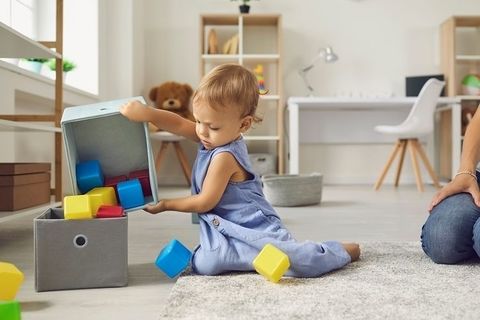How many times have you raised your voice out of frustration and yelled at your child “clean your room!” How did that go?
Whether your kids are toddlers or teenagers there are steps you can take to get the results you’re looking for. If you still have small children at home, you can get started right away by teaching them skills and giving encouragement. Older kids can also learn the skills and habits that will take them into adulthood.
Show Don’t tell
One mistake a parent can make is to simply tell a child to clean his room without defining what that means. It’s important to be specific with your instructions. For example, tell your child “fold your pajamas and put them in your dresser drawer.” “Put your shoes on the shoe rack.” “Hang shirts in your closet.” It may seem obvious to us because we’ve been doing it for years, but to a child it’s a skill to be learned and repeated until it becomes a habit.
Have Reasonable Expectations
Children as young as toddlers like to imitate their parents’ habits and routines. It could be sweeping a floor, sorting laundry, or clearing the table after dinner. When these teachable moments arise invite your child to help you and praise them for their efforts. Give them simple tasks they can be successful at and eventually do on their own. These can then become their responsibility when they’re ready. If you’re not sure which tasks are age appropriate here is a link with information, from Dr. Robert Myers, PhD of The Child Development Institute. https://childdevelopmentinfo.com/chores/the-ultimate-list-of-age-appropriate-chores/#gs.7slcoz
Agree on the Rules
It’s important for your kids to know what chores are expected of them, and for you to be consistent about their implementation. It will confuse them if you’re strict one day and lax the next. Without consistency they’ll begin testing you to see how far they can push the boundaries, and the gains you make at the beginning can be lost.
One way to get buy-in from your older kids is to have a family meeting to discuss the chore list and decide which are most suited to each person. Ask them about their preferences. If your kids want to share duties, trade from week to week, or work as a team, let them.
Sometimes chore charts are helpful. They can give your child the satisfaction of seeing a check mark in the spot of a completed task. Consider a follow up meeting to discuss successes, challenges, and adjustments, or make the meetings a recurring event to keep your kids engaged and committed. Make it fun. Order a pizza or make ice cream sundaes so your kids look forward to it rather than dread it.
Habits Grow with Repetition
In the beginning remember to model the behaviors you want to see. Work with your child to organize their bedroom or toy room. Describe the steps you’re taking and have them participate with you. Don’t expect perfection and avoid the temptation to re-do their work. It will send the wrong message.
The younger the child is the more often you’ll need to walk them through the steps. As adults we forget how much we take for granted. Through repetition and practice your child will become confident and simultaneously form a positive habit. Offer appropriate rewards and encouragement each time you see the behaviors you want.
Toy Room Hacks
A lot of parents tell me how frustrating it is to keep their kids’ toy room tidy and organized. They seem to get messy again so quickly. Just remember that some disorganization is inevitable. You can minimize it, but it will probably never be perfect. Here are some tips that may help.
-
- Try to reduce the number of new toys that enter the home. Ask grandparents to donate to a college fund, or aunts and uncles to take your child to a movie or the zoo.
- Once or twice a year go through the toys and donate the ones that aren’t being used
- Keep some games and toys in reserve. Everything doesn’t always need to be available. Too many toys can be overwhelming
- Make it easy for your child to put things away. Use open bins and drawers that don’t require a lot of sorting
- Keep puzzles and board games with a lot of tiny pieces, out of young children’s reach.
- Store art supplies in a place where parents can supervise their use.
- Keep stuffed animals and dress up clothes in mesh laundry basket or soft basket to make cleanup quick and easy.
- Label containers with words for older kids and pictures for the little ones
- Make sure you have plenty of storage options like shelving, cupboards, bins, and containers so that everything has a place.
- Use clear containers for easy identification
- If items are heavy put fewer in a container and keep closer to the floor for easy access
By teaching your child skills and responsibilities during their early years you’re setting them up for a successful adulthood. It may not always be easy but in the long run you’ll be happy you did. Who knows, your child may thank you one day.

